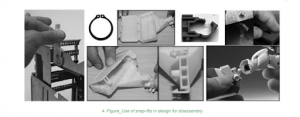Lesson 1: Eco product design strategies i.: design for minimal use of materials, and design for disassembly (DfD)
In this lesson, we will explore two essential eco-product design strategies: Design for Minimal Use of Materials and Design for Disassembly (DfD). These strategies are integral in creating products that are environmentally friendly, resource-efficient, and easy to recycle.
- DESIGN FOR MINIMAL USE OF MATERIALS
Designing products with minimal material usage is a fundamental principle of eco-design. It involves simplifying product components and shapes to achieve resource efficiency.
Minimization of Resource Utilization:
- Reducing material usage offers several benefits, including lower raw material extraction, decreased energy consumption during processing, and reduced emissions from transportation and production.
Simplicity:
- Simplicity is a key principle in the embodiment phase of design. It ensures economic feasibility and minimizes resource consumption. Simplicity entails using a minimal number of parts with basic forms that are easy to understand and manufacture.
Simplicity in Production and Quality Control:
- Designing for simplicity in production involves choosing shapes compatible with established production methods, which saves time and resources.
Simplicity in Assembly Processes:
- Creating products with easy-to-follow assembly instructions and clear identification of components simplifies the manufacturing process.
Simplicity for Recycling:
- Promoting recyclability through material choice, simple assembly and disassembly procedures, and uncomplicated components aids in the recycling process.
Simplicity in Packaging:
- Reducing packaging layers, including primary, secondary, and tertiary packaging, helps minimize waste and environmental impact.
Material Change:
- Sometimes, changing materials becomes necessary due to cost, hazards, or other reasons. Material change should be informed by data on both the new and old materials to ensure product quality and performance.
- DESIGN FOR DISASSEMBLY (DfD)
Designing products with disassembly in mind simplifies recycling and reduces waste. This approach ensures that products can be taken apart efficiently.
Principles for Disassembly:
- Designing for easy access to parts and fasteners without damaging them.
- Embracing modular product design.
- Reducing the mass of individual parts and modules.
- Using fastening and bonding techniques that allow for disassembly without causing damage.
- Minimizing the number of breakable parts.
- Enabling easy reassembly.
- Allowing the use of standard hand tools for disassembly.
- Designing for easy alteration to facilitate reprocessing and adjustment.
Disassembly for Recycling:
- Disassembling products with recycling in mind involves selective separation of parts and materials, aiming to increase material recovery while considering costs, benefits, landfill disposal, and environmental impact.
VDI 2243 Recommendations:
- VDI 2243 provides guidelines for DfD in three recycling phases: during production, during product use (reparation), and after product use (end-of-life recycling).
New Types of Fasteners:
- Innovative fasteners like shape memory alloys and polymers can simplify disassembly by allowing the product to break down into parts when heated and cooled.
Manual Disassembly:
- Tools for disassembly should be chosen based on fastener type, efficiency, and accessibility.
Mechanical Disassembly:
- In mechanical disassembly, not all metal content is recovered, as some remains attached to other materials after crushing. The percentage of metal content is a critical criterion for selecting this method.

Conclusion:
- Designing products with minimal material usage and ease of disassembly is essential for eco-friendly and sustainable product development.
- These strategies reduce resource consumption, promote recycling, and contribute to a cleaner environment.
- Eco-product designers should consider the entire lifecycle of a product, from production to disposal, to ensure responsible and resource-efficient design.